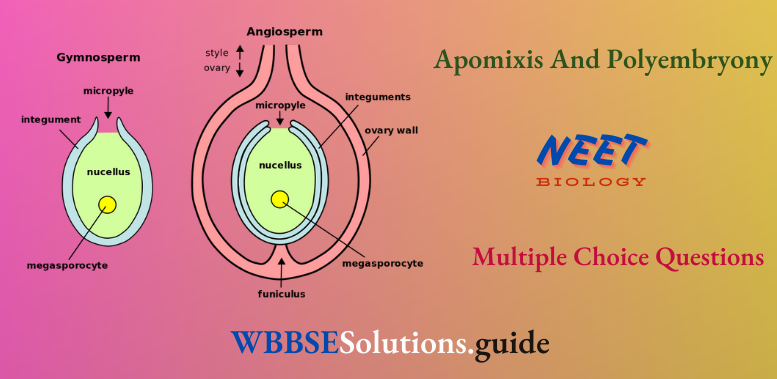NEET Biology Mcqs Apomixis and Polyembryony
Question 1. ‘Apomixis’ term was given by
- Focke
- Swingle
- Winkler
- Nawaschin
Answer: 3. Winkler
In botany, apomixis was defined by Hans Winkler as replacement of normal sexual reproduction by asexual reproduction without fertilisation.
Read And Learn More: NEET Biology Multiple Choice Question And Answers
Question 2. Seed formation without fertilisation in flowering plants involves the process of
- Sporulation
- Budding
- Somatic hybridisation
- Apomixis
Answer: 4. Apomixis
Apomixis is a special process found to generate seeds without fertilisation in flowering plants. It is a form of asexual reproduction that mimics sexual reproduction.
NEET Biology Apomixis and Polyembryony MCQs with Answers
Question 3. What is common between vegetative reproduction and apomixis?
- Both are applicable to only dicot plants
- Both bypass the flowering phase
- Both occur round the year
- Both produce progeny identical to the parent
Answer: 4. Both produce progeny identical to the parent
- Apomixis is a reproductive process in plants that superficially resembles normal sexual reproduction but in which there is no fusion of gametes.
- The embryos develop simply by division of a diploid cell of the ovule. So, both vegetative reproduction and apomixis produce progeny identical to the parent.
NEET Biology Mcqs Chapter Wise

Important MCQs on Apomixis and Polyembryony for NEET
Question 4. In a type of apomixis known as adventive embryony, embryos develop directly from the
- Nucellus or integuments
- Synergids or antipodals in an embryo sac
- Accessory embryo sacs in the ovule
- Zygote
Answer: 1. Nucellus or integuments
Adventive embryo formation is a type of apomixis in which embryos are formed from diploid integumental or nucellar cells.
Question 5. Apomictic embryos in citrus arise from
- Synergids
- Maternal sporophytic tissue in ovule
- Antipodal cells
- Diploid egg
Answer: 2. Maternal sporophytic tissue in ovule
In Citrus, apomictic embryos arise from maternal sporophytic tissue like nucellus and integuments in ovule. This type of embryo is called adventive embryo.
Question 6. Assertion (A) In apomixis, plants of new genetic variations are not produced. Reason (R) In apomixis, reductional division takes place.
- Both A and R are true and R is the correct explanation of A
- Both A and R are true, but R is not the correct explanation of A
- A is true, but R is false
- Both A and R are false
Answer: 4. Both A and R are false
- Both A and R are false and can be corrected as Apomixis is a kind of asexual reproduction in which viable embryo is formed within the confines of the seed coat, without meiosis and syngamy.
- Since, it is an asexual reproduction, the offspring produced are identical to the parent plants. In apomixis, embryos are formed from gametophytic or sporophytic cells which undergo stages of embryogeny and eventually develop into mature embryos
Difference Between Apomixis and Polyembryony MCQs for NEET
Question 7. Seedless watermelons are produced by crossing between
- Triploid female plant with diploid male plant
- Tetraploid female plant with tetraploid male plant
- Diploid female plant with tetraploid male plant
- Tetraploid female plant with diploid male plant
Answer: 4. Tetraploid female plant with diploid male plant
Seedless watermelons are triploid. They have three sets of chromosomes. This odd number results in them being sterile and not producing seeds. The way they become triploid is by mating a diploid male with a tetraploid female.
Question 8. Occurrence of more than one embryo is called
- Polyembryony
- Embryony
- Parthenogenesis
- Fertilisation
Answer: 1. Polyembryony
Occurrence of more than one embryo is called polyembryony. It is generally found in family–Citraceae. Orange and lemon are common examples of polyembryony.
NEET Biology Mcqs Chapter Wise
Question 9. Adventive polyembryony in Citrus is due to
- Nucellus
- Integuments
- zygotic embryo
- Fertilised egg
Answer: 1. Nucellus
- In Citrus, many embryos are formed from the structures outside the embryo, i.e. nucellus.
- This is commonly called adventive polyembryony. In Citrus, up to 10 nucellar embryos are formed.
“endosperm is present in mature seeds of “
Question 10. In which of the following cleavage, polyembryony is observed?
- Lobelia
- Argemone mexicana
- Phaseolus vulgaris
- Mangifera
Answer: 1. Lobelia
NEET Biology Asexual Reproduction and Polyembryony MCQs
In cleavage polyembryony, zygote gets cleaved into two or more units, e.g. Nicotiana rustica, Lobelia, etc. It is common in gymnosperms, but it is of rare occurrence in angiosperms.
Question 11. The phenomenon of polyembryony was first observed in
- Citrus
- Mangifera
- Cucurbita
- Euphorbia
Answer: 1. Citrus
Strasburger in 1878 first observed the regular occurrence of polyembryony in certain species of Citrus in nature.
“gynoecium of michelia “
Question 12. In Argemone mexicana and Phaseolus vulgaris, embryos develop
- By cleavage of zygote
- From synergids and antipodal
- From nucellus and integuments
- From endosperm
Answer: 2. From synergids and antipodal
The embryo may develop from synergids and antipodal cells in the embryo sac in Argemone mexicana and Phaseolus vulgaris. These embryos are haploid in nature.
NEET Exam Apomixis and Polyembryony Most Repeated MCQs
Question 13. The ‘necrohormone theory’ for the induction of polyembryony was proposed by
- Leroy
- Haberlandt
- Maheshwari
- Winkler
Answer: 2. Haberlandt
Haberlandt proposed the ‘necrohormone theory’ for the induction of polyembryony in the year 1991-1992
